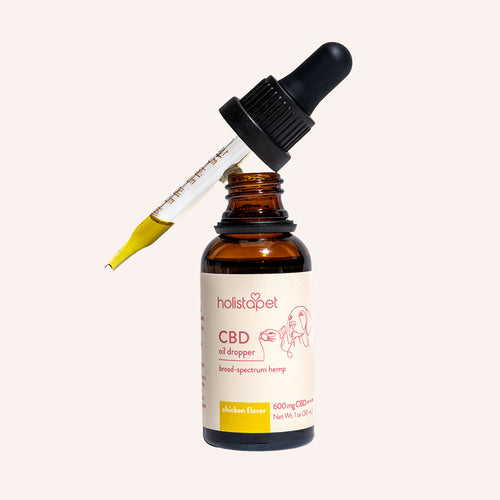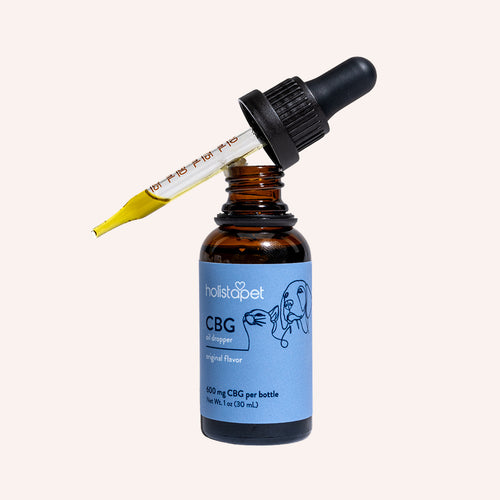Galliprant is a kind of non-steroidal anti-inflammatory drug (NSAID) that is highly effective in treating canine osteoarthritis. But is Galliprant good for dogs? When paired with a cannabis extract known as cannabidiol (CBD), both the symptoms and underlying conditions of Arthritis can be properly managed. CBD taken for arthritis is well tolerated in dogs and has numerous other benefits besides just treating canine osteoarthritis.
What Is Galliprant?
In May of 2018, the Food & Drug Administration (FDA) approved a new drug known as Galliprant, specifically designed for canine use. Galliprant is a nonsteroidal anti-inflammatory drug (NSAID) that comes in the form of a tablet. Its active ingredient, grapiprant, functions as a selective antagonist of the prostaglandin EP4 receptor, a key receptor involved in mediating pain and inflammation in dogs, particularly those suffering from osteoarthritis.
Administered orally, Galliprant is rapidly absorbed, with a favorable pharmacokinetic profile that ensures quick onset of action. The bioavailability of Galliprant is optimized when given on an empty stomach, though it can be administered with dog food if needed to prevent stomach upset. The drug is metabolized in the liver and excreted primarily through the feces and urine.
Galliprant has been a game-changer in veterinary medicine, providing a safer alternative for dogs with chronic pain and inflammatory conditions. By targeting the prostaglandin receptor involved in osteoarthritis, it allows for long-term management of pain without compromising the dog's kidney and liver functions. This makes it a preferred choice for many veterinarians when managing canine osteoarthritis and other inflammatory conditions.
What is Galliprant Used for in Dogs?
Galliprant works by specifically blocking the prostaglandin E2 receptor, which is responsible for most of the pain and inflammation associated with osteoarthritis. This selective action allows Galliprant to provide effective pain management while minimizing adverse effects on the gastrointestinal tract, kidney, and liver—common concerns with traditional therapy like meloxicam and carprofen.
Canine osteoarthritis is an unfortunately common condition. Some estimates state that it affects up to 1 in 4 dogs in the United States alone. Furthermore, there are approximately 90 million dogs in the country, meaning that about 22 million dogs suffer from the condition. Canine osteoarthritis is also sometimes referred to as degenerative joint disease (DJD). Symptoms of these conditions can reduce mobility and cause discomfort in your furry friend. The most common symptoms of canine osteoarthritis include:
- Stiffness
- Limping
- Getting up and/or laying down slowly or awkwardly
- Reluctance and/or inability to walk and jump
- Pain and discomfort (which dogs exhibit by excessively panting)
- Excessively sleeping

Canine osteoarthritis is an inflammatory disease. Inflammation in the mammalian body is a response to some form of trauma or distress. It causes pain, stiffness, tenderness, and/or swelling. All the blood vessels in the affected area dilate (get bigger). This causes increased blood flow to the area.
The mammalian body does this to deliver more cytokines (communication cells that trigger an immune response) to the affected areas. This response occurs because the biofeedback mechanisms in the mammalian body determine that there is some trauma or distress present there.
Inflammation can occur anywhere in the mammalian body. If the inflammation is chronic, this is usually as a result of some underlying condition (like osteoarthritis). Chronic inflammation damages cells. This eventually causes serious medical complications, including various forms of osteoarthritis.
How Does Galliprant Work For Arthritis In Dogs?
It is useful to know that there are two basic types of compounds that interact with receptors in the mammalian body:
Agonists: These bind with a receptor and cause an increased response.
Antagonists: These bind with a receptor and dampen or decrease a response (also referred to as blockers).
Galliprant is the market name for grapiprant for dogs. This compound is aprostaglandin receptor antagonist (PRA). This just means that it is a compound that interferes with prostaglandin receptors. The prostaglandin receptor responsible for canine OA pain and inflammation is known as theEP4 receptor. That means that Galliprant specifically targets EP4 receptors and inhibits their ability to cause pain and inflammation in the dog's joints.
What Are NSAIDs For Dogs?
Non-steroidal anti-inflammatory drugs (NSAIDs) are commonly used in veterinary medicine to manage pain, inflammation, and discomfort in dogs, especially for conditions like arthritis or post-surgical pain. These medications work by reducing inflammation and relieving pain, and several different NSAIDs are specifically formulated for canine use:
Carprofen (Rimadyl)
Carprofen, marketed under the brand name Rimadyl, is one of the most widely used NSAIDs for dogs. It is often prescribed for pain relief and inflammation associated with osteoarthritis or post-operative recovery, and it's known for its relatively mild side effects.
Meloxicam (Metacam)
Meloxicam, sold as Metacam, is another popular NSAID for managing chronic pain in dogs, particularly those with arthritis. It is available in liquid form, making it easier to dose, and is generally well-tolerated with regular veterinary monitoring.
Deracoxib (Deramaxx)
Deracoxib, or Deramaxx, is commonly prescribed for both long-term pain management in osteoarthritis and short-term pain relief following surgeries like orthopedic procedures. This NSAID is known for being effective, though it requires careful monitoring for any adverse effects on the gastrointestinal system.
Firocoxib (Previcox)
Firocoxib, marketed as Previcox, is often used for treating inflammation and pain associated with osteoarthritis and post-operative pain in dogs. It is particularly recommended for long-term pain management and is considered safe when used as directed.
Etodolac (EtoGesic)
Etodolac, sold under the brand name EtoGesic, is an NSAID commonly prescribed for dogs with arthritis. It helps reduce joint pain and inflammation, improving mobility, and is typically used for long-term management of chronic pain. Like other NSAIDs, it should be monitored for potential side effects, particularly on the gastrointestinal system and kidneys.

Side effects of NSAIDs include:
- Serious gastrointestinal distress (diarrhea and vomiting)
- Stomach ulcers can become irritated and cause internal hemorrhaging
- Serious weight loss
- Irreversible liver and kidney damage
- Dehydration and urinary problems
- Seizures
- Aggressive behavior
- Abdominal pain
- Death from organ failure
Galliprant Side Effects
Although Galliprant is commonly used to manage osteoarthritis pain in dogs, it's essential to be aware of the possible side effects it may cause for healthy dogs. Understanding these risks can help you monitor your dog’s health and address any issues that arise during treatment.
Gastrointestinal Issues
Galliprant can cause digestive problems in some dogs, leading to symptoms such as vomiting, diarrhea, and a decrease in appetite. In more severe cases, gastrointestinal ulcers or bleeding may occur, requiring prompt veterinary attention.
Kidney and Liver Concerns
This medication can sometimes affect kidney or liver function, particularly in dogs with preexisting conditions. Regular monitoring of liver and kidney values through blood tests is recommended during long-term use to catch any early signs of damage.
Lethargy and Behavioral Changes
Dogs on Galliprant may experience lethargy or general tiredness as a side effect. Behavioral changes, such as increased irritability or withdrawal, can also occasionally be observed and should be reported to a veterinarian if persistent.
Allergic Reactions
In rare instances, dogs may have an allergic reaction to Galliprant, which could present as swelling, hives, or difficulty breathing. Immediate veterinary care is necessary if any signs of an allergic reaction occur, especially for lactating dogs or dogs younger than the average adult canine.
Weight Loss
Unexplained weight loss has been reported as a potential side effect of Galliprant in some dogs. This could be tied to digestive issues or a loss of appetite, and should be investigated if it becomes noticeable.
Drug Interactions
Galliprant may interact with other medications, particularly other NSAIDs, corticosteroids, or drugs affecting the liver. It is important to inform your vet about all medications your dog is taking to avoid harmful interactions.
In the case of conventional canine NSAIDS, certain side effects are irreversible. These include potential liver and kidney damage. In some cases, the dogs may even die due to organ failure. CBD is also safe to use on a daily basis.
CBD Versus Galliprant
Cannabidiol (CBD) is one of the many extracts from the cannabis plant, specifically from its flowers, leaves, and stalks. CBD belongs to a group of naturally occurring compounds known as cannabinoids, of which the cannabis plant contains approximately 80. CBD has gained attention in recent years as an alternative or complementary option for managing pain, inflammation, and other conditions in pets.
There are key differences between CBD and Galliprant in their modes of action, efficacy, and safety profiles. While Galliprant specifically targets the prostaglandin EP4 receptor, a receptor involved in mediating pain and inflammation associated with osteoarthritis, CBD works more broadly within the ECS and is less specific in its actions. This means that while CBD may offer some relief for inflammation and pain, it does not directly target the same pathways as Galliprant and may therefore be less effective in treating conditions like canine osteoarthritis.
Benefits Of CBD Oil For Dogs:
- Reduces discomforts as an analgesic, with no potential side effects
- Reducing nausea and/or vomiting
- Reducing gastrointestinal distress, including diarrhea
- Treating restlessness, agitation, and/or anxiety in dogs
- Allowing the dog to get healthy sleep
- Reducing muscle spasms and/or tremors
- Increasing cardiovascular health (improving levels of “good” fat in the mammalian body)
- Reducing inflammation all over the body
- Decreasing the risk of diabetes by maintaining healthy blood sugar levels
CBD Oil is most useful in treating canine osteoarthritis due to its ability to decrease levels of pain and inflammation. The mammalian body has a network of receptors known as the endocannabinoid system (ECS). The ECS governs inflammation. Cannabinoid receptors are located all over the mammalian body and are primarily responsible for modulating inflammation.
CBD decreases inflammation by regulating the compounds that bind to these receptors. CBD also stimulates the natural cannabinoids in the mammalian body. These are known as endocannabinoids. All of these effects help the ECS maintain a balanced and healthy state of functioning.
There is a type of receptor closely related to cannabinoid receptors known as TRPV1 receptors. These are located primarily in the peripheral nervous system within pain receptors. CBD also interacts with these TRPV1 receptors, effectively keeping pain and inflammation levels low all over the body. This includes the joints that are so seriously affected by osteoarthritis.
CBD can act as an effective complement to a medication regimen that includes Galliprant. Because of its incredible efficacy in treating osteoarthritis, as well as its wide range of benefits for a variety of ailments, introducing a daily dose of CBD will improve the quality of life for any dog.

Can CBD Be Used With Galliprant?
It is important to administer CBD under veterinary supervision. This is because it inhibits the function of a certain liver enzyme known as cytochrome P450. These particular enzymes are absolutely vital in the metabolism of nearly 60% of all veterinary medications. However, most veterinarians agree that CBD is safely and effectively taken with Galliprant to treat osteoarthritis.
First off, make sure to choose CBD products made for pets. Also, choose products that have clearly marked dosage amounts. It is generally impossible to overdose on CBD, but it is still best to administer the medication in a measured and responsible manner to avoid allergy triggers or other adverse effects.
Recommended: See Our Pet CBD Dosing Chart Guide Here!
CBD will make a huge difference in a dog's quality of life. It promotes overall health and wellness with generally no side effects. CBD oil is administered as a tincture, available in 150, 300, or 600 milligram bottles. There are also CBD doggie treats that can be used to reward a dog for good behavior or as a training tool. CBD is safe, natural, and extremely effective. While you're here, why not learn about more home remedies for dogs or browse our website here.
Final Thoughts
When it comes to managing your dog's pain and inflammation, especially in conditions like osteoarthritis, both CBD oil and Galliprant offer potential benefits. Understanding the differences between these options, as well as how they can complement each other, is key to making the best choice for your pet's health.


 CBD Oil for Dogs - Fast Acting
CBD Oil for Dogs - Fast Acting
 Chicken Flavored CBD Oil For Dogs - Easy Dose
Chicken Flavored CBD Oil For Dogs - Easy Dose
 Salmon Flavored CBD Oil For Dogs - Highly Rated
Salmon Flavored CBD Oil For Dogs - Highly Rated
 CBG Oil for Dogs and Cats - Loved by Thousands
CBG Oil for Dogs and Cats - Loved by Thousands





Leave a comment
All comments are moderated before being published.
This site is protected by hCaptcha and the hCaptcha Privacy Policy and Terms of Service apply.